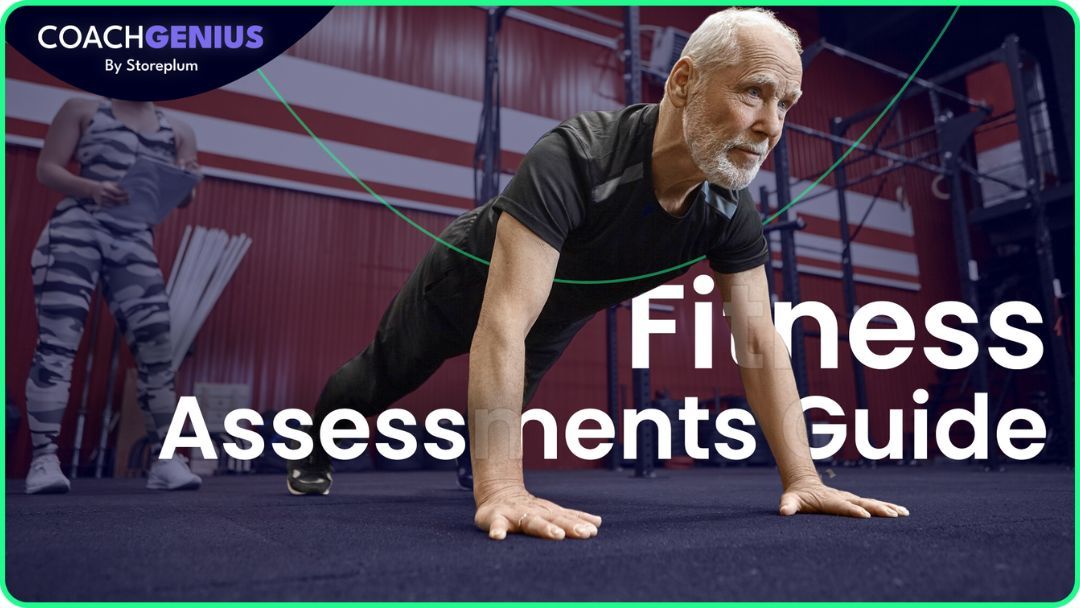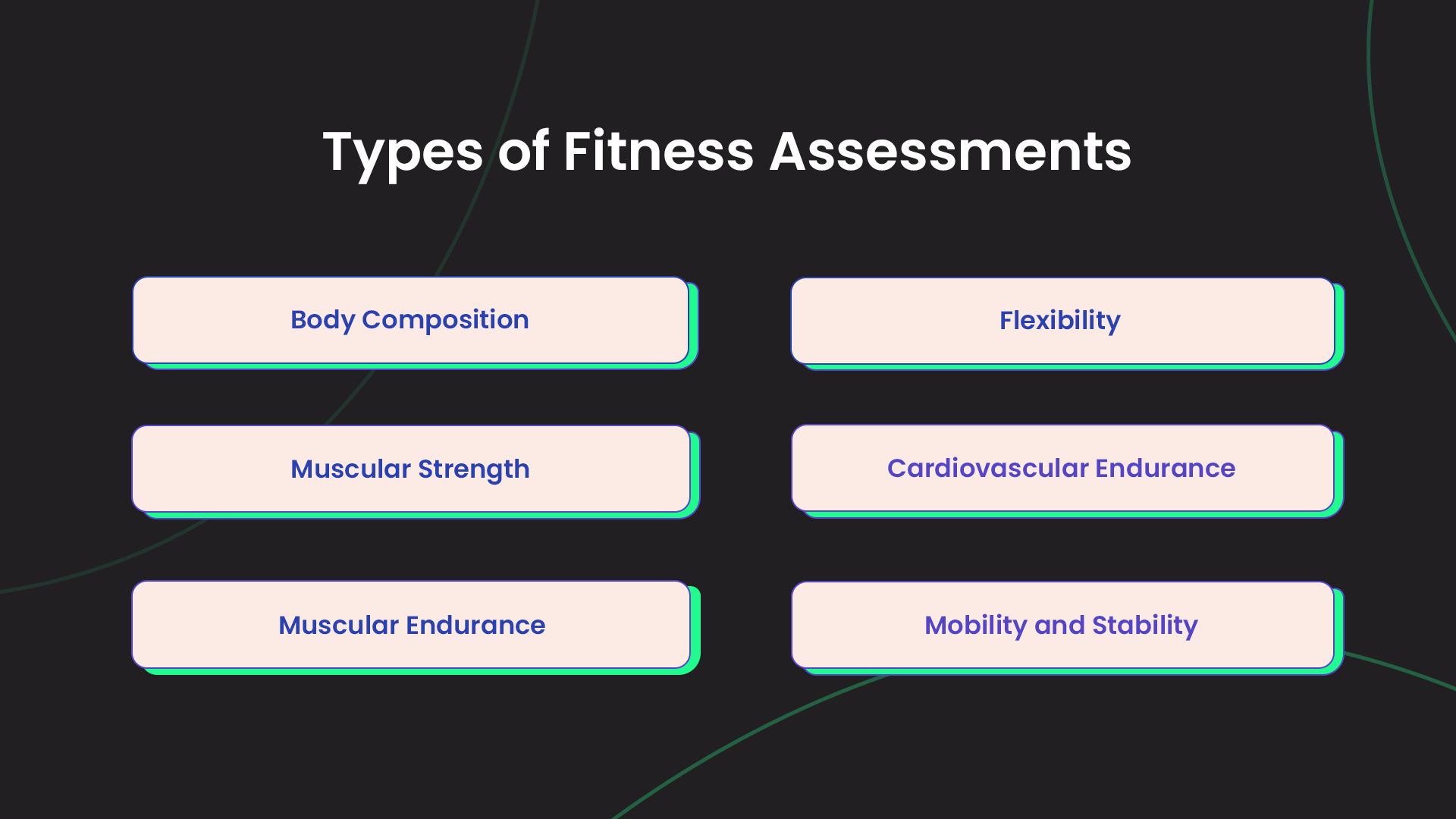A Comprehensive Guide to Fitness Assessments

By Pritesh Baviskar
Posted Fri, Mar 8, 2024 | 9 min read

As a fitness professional, you cannot start training a client without first being able to judge what their body needs. While some information can be gleaned from the clients themselves and from recent medical records, facts about their physical conditioning and other facets are best inferred after conducting a thorough fitness assessment.
What exactly are fitness assessments? What is included in a fitness assessment? Why is it important to conduct fitness assessments? The answer to these and other questions are in this comprehensive guide to fitness assessments.
What Are Fitness Assessments?
Fitness assessments are systematic evaluations or tests conducted to measure various aspects of an individual's physical fitness, health, and performance. These assessments are commonly used in the fields of exercise science, sports, and healthcare to gather information about a person's overall fitness level, identify strengths and weaknesses, and design personalized exercise programs.
Fitness assessments can cover a range of factors, including cardiovascular endurance, muscular strength and endurance, flexibility, body composition, and other relevant health markers.
Types of Fitness Assessments
Fitness assessments provide valuable information that help fitness trainers with designing personalized fitness programs, monitoring progress, and identifying areas for improvement or potential injury risks. It's crucial to conduct these assessments with proper supervision and adherence to safety guidelines.
Let’s take a look at some of the most conducted fitness assessments, and how they are conducted.

1. Body Composition
Definition: Body composition refers to the distribution of fat and lean mass in the body.
Assessment: Common methods include BMI (Body Mass Index), skinfold thickness measurements using calipers, bioelectrical impedance analysis (BIA), and dual-energy X-ray absorptiometry (DEXA).
Conducting the Assessment: For skinfold measurements, calipers are used to pinch and measure the thickness of subcutaneous fat at specific sites on the body. Other methods involve using technology to analyze the body's electrical conductivity or X-rays to differentiate between fat and lean tissues.
2. Muscular Strength
Definition: Muscular strength is the maximal force a muscle or group of muscles can generate.
Assessment: Common exercises include the bench press, leg press, or one-repetition maximum (1RM) tests for specific muscle groups.
Conducting the Assessment: Individuals perform these exercises with progressively heavier weights until they reach their maximum effort for one repetition. The maximum weight lifted is recorded as the individual's muscular strength for that exercise.
3. Muscular Endurance
Definition: Muscular endurance is the ability of muscles to sustain repeated contractions over an extended period.
Assessment: Exercises such as push-ups, sit-ups, or bodyweight squats are commonly used.
Conducting the Assessment: Individuals perform as many repetitions as possible of a specific exercise within a set time or until fatigue. The number of repetitions completed indicates muscular endurance.
4. Flexibility
Definition: Flexibility is the range of motion around a joint.
Assessment: Common tests include the sit-and-reach test or shoulder flexibility test.
Conducting the Assessment: Individuals perform specific movements that target different joints, and the distance or degree of movement is measured. For example, in the sit-and-reach test, the distance reached beyond the toes is an indicator of flexibility.
5. Cardiovascular Endurance
Definition: Cardiovascular endurance is the ability of the heart and lungs to deliver oxygen to working muscles during sustained physical activity.
Assessment: Treadmill tests, 1-mile run, or the beep test are common methods.
Conducting the Assessment: Individuals perform aerobic exercises at a specific intensity level for a set duration. Measurements may include time to exhaustion, distance covered, or heart rate response.
6. Mobility and Stability
Definition: Mobility refers to the range of motion around a joint, while stability refers to the ability to maintain control and support during movement.
Assessment: Functional Movement Screens (FMS) or specific tests for joint mobility and stability.
Conducting the Assessment: Individuals perform a series of movements that challenge both mobility and stability. Observations are made for any compensations, imbalances, or limitations in movement patterns.
Fitness Assessments Based on Age
In addition to the above fitness assessments, some tests are conducted based on the age of the client as well. Let’s take a look at these age-based fitness assessments.
The Senior Fitness Test
The Senior Fitness Test is a battery of assessments designed specifically for older adults (ages 60 to 94) to evaluate their functional fitness levels. It was developed by Dr. Roberta Rikli and Dr. Jessie Jones and is widely used to assess the physical capabilities of seniors, helping to identify areas of strength and areas that may require attention. The test is often employed by fitness professionals, healthcare providers, and researchers working with older populations.
The Senior Fitness Test consists of six components, each assessing different aspects of functional fitness.
1. Chair Stand
Objective: Measures lower body strength and endurance.
Procedure: Participants rise from a seated position to a full stand as many times as possible within 30 seconds.
2. Arm Curl
Objective: Assesses upper body strength and endurance.
Procedure: Participants perform as many bicep curls as possible with a specified weight in 30 seconds.
3. Chair Sit and Reach
Objective: Evaluates lower body flexibility.
Procedure: Participants sit on the edge of a chair, extending one leg and reaching toward their toes, measuring the distance reached.
4. Back Scratch
Objective: Measures upper body flexibility.
Procedure: Participants attempt to touch or overlap their fingers behind their back, one hand reaching down the back and the other up from below.
5. 8-Foot Up-and-Go
Objective: Assesses agility and dynamic balance.
Procedure: Participants rise from a seated position, walk 8 feet, turn, return, and sit back down as quickly as possible.
6. 6-Minute Walk
Objective: Evaluates aerobic endurance and walking speed.
Procedure: Participants walk as far as possible in 6 minutes.
Fitness Assessments for Children or Fitnessgram
Fitnessgram is a comprehensive fitness assessment and reporting program designed for use in schools to evaluate and promote the physical fitness of students. Developed by The Cooper Institute, Fitnessgram aims to provide a more holistic approach to fitness assessment by focusing on health-related components rather than just athletic performance. The program is widely used in physical education settings to encourage and track the development of a healthy and active lifestyle among students.
Key features of Fitnessgram include:
1. Health-Related Fitness Components
Fitnessgram assesses various health-related components, including cardiovascular fitness, muscular strength and endurance, flexibility, and body composition. This approach provides a more balanced view of overall fitness and health.
2. Personalized Assessment
Fitnessgram takes into account individual differences by using criterion-referenced standards rather than normative standards. This means that students are evaluated based on established health criteria rather than comparison to their peers.
3. Goal Setting and Educational Feedback
The program emphasizes goal setting and provides educational feedback to students, parents, and educators. This information helps individuals understand their fitness levels, set realistic goals, and make informed decisions about improving their health.
4. Long-Term Tracking
Fitnessgram encourages the tracking of fitness levels over time, allowing individuals to monitor their progress and make adjustments to their physical activity routines. This long-term perspective supports the development of lifelong habits of regular physical activity.
5. Inclusivity
The program is designed to be inclusive and adaptive, accommodating individuals with varying abilities and fitness levels. Fitnessgram promotes the idea that everyone can improve their health and fitness with appropriate guidance and effort.
6. Educational Resources
Fitnessgram provides educational resources and materials for teachers, students, and parents to promote a better understanding of the importance of physical fitness and overall well-being.
By integrating Fitnessgram into school physical education programs, educators can play a vital role in fostering a culture of health and fitness among students. It not only assesses fitness levels but also empowers individuals to take an active role in their own health and fitness journey.
The Benefits of Conducting Fitness Assessments
Fitness assessments play a crucial role in promoting overall well-being and aiding individuals in their fitness journeys. Here's an in-depth exploration of the key benefits associated with conducting fitness assessments:

1. Motivational Improvement
Fitness assessments provide individuals with tangible and measurable data about their current fitness levels. Seeing progress or identifying areas for improvement can be highly motivating. Achieving specific goals based on assessment results boosts self-confidence and encourages a sense of accomplishment, motivating individuals to maintain or enhance their fitness efforts.
2. Assessing Fitness Levels
Fitness assessments serve as a baseline measure of an individual's current physical condition. By evaluating components such as cardiovascular fitness, muscular strength, flexibility, and body composition, one gains a comprehensive understanding of their strengths and weaknesses. This information is valuable for designing targeted exercise programs that address specific needs.
3. Enhanced Mental Well Being
Regular fitness assessments are linked to improved mental well-being. Engaging in physical activity has known benefits for mental health, including stress reduction and mood enhancement. Understanding one's fitness levels and witnessing positive changes over time contributes to a sense of control and emotional well-being.
4. Identifying Personal Fitness Goals
Fitness assessments provide insight into areas that may need improvement or maintenance. This information is crucial for setting realistic and achievable fitness goals. Whether it's increasing cardiovascular endurance, building muscle strength, or improving flexibility, personalized goals can be established based on assessment results, creating a roadmap for success.
5. Health Risk Prevention
Fitness assessments can help identify risk factors for various health conditions. For instance, assessments of body composition and cardiovascular fitness may reveal indicators of obesity or cardiovascular disease risk. Recognizing these factors early allows individuals and healthcare professionals to implement preventive measures, such as lifestyle changes and targeted exercise programs, reducing the risk of developing chronic health issues.
6. Determine Injury Recovery
For individuals recovering from injuries, fitness assessments are instrumental in determining the appropriate level of activity and tracking progress. These assessments assist healthcare professionals and rehabilitation specialists in creating rehabilitation plans that are tailored to the individual's capabilities, ensuring a safe and effective recovery process.
Conclusion
Fitness assessments are an essential tool for fitness professionals across the board. Be it planning an exercise regimen, improving mental wellbeing or charting a recovery course after an injury, fitness assessments guide trainers and their clients with the best path to take.
When you as a fitness professional choose CoachGenius to help you build your professional website, you get access to some of our assessment tools, such as the BMI calculator.
You can also plan workouts and diets for specific clients to follow, among a host of other features. From scheduling and online payments to your very own e-store and much more, your CoachGenius website has your every fitness website need covered.
Start your free CoachGenius trial today, and give your fitness training profile the boost it deserves.

I'm one of the founders at CoachGenius. As someone with a genuine understanding of the online coaching landscape, I'm no stranger to the challenges faced by personal trainers. I like to write about goal setting techniques, building personal brand and creating engaging online content related to fitness.
